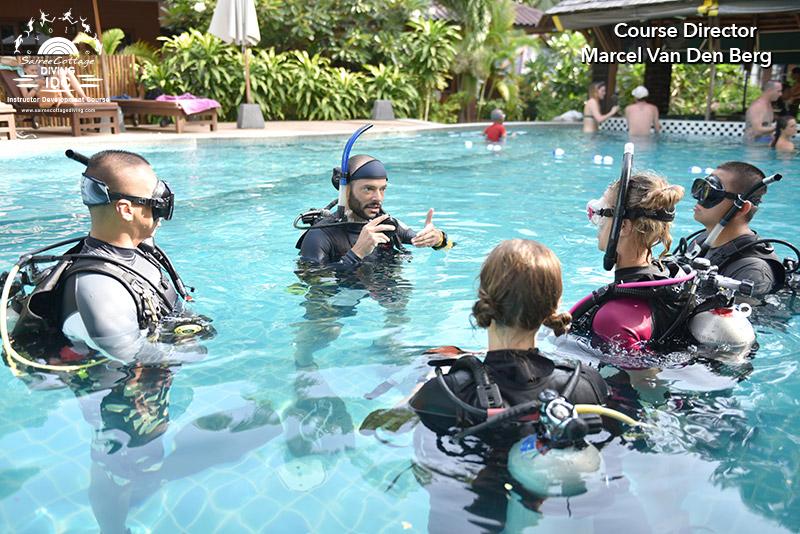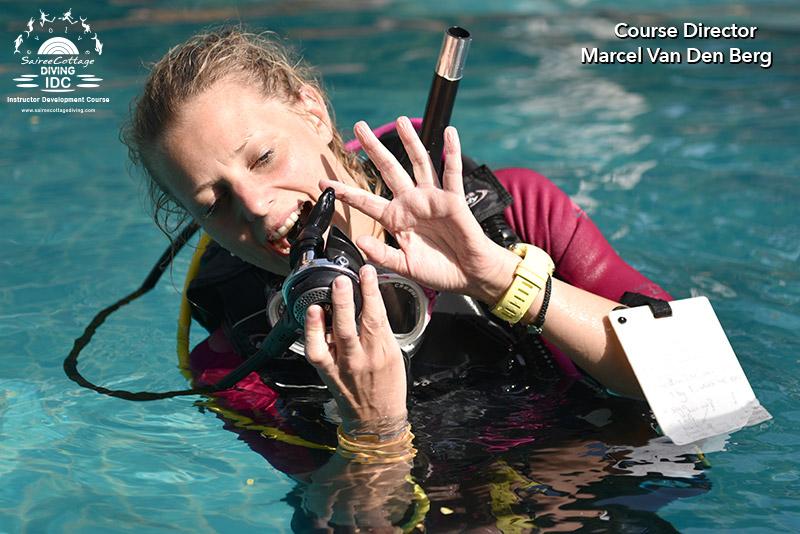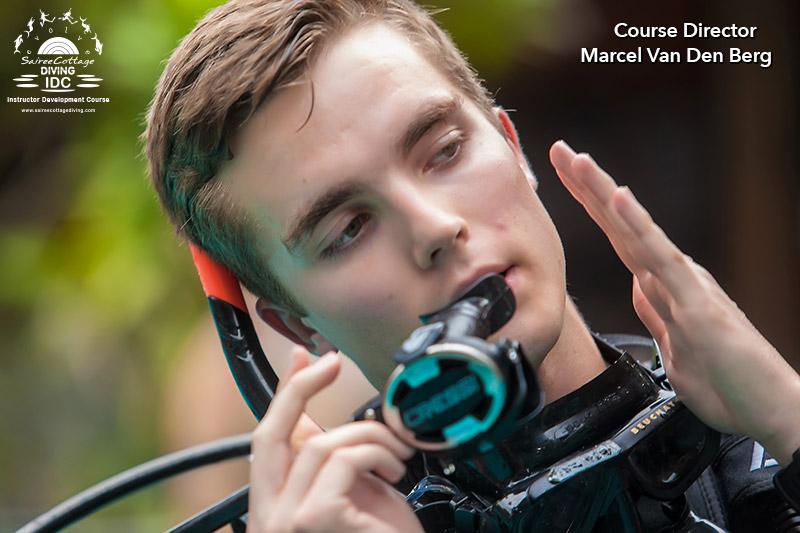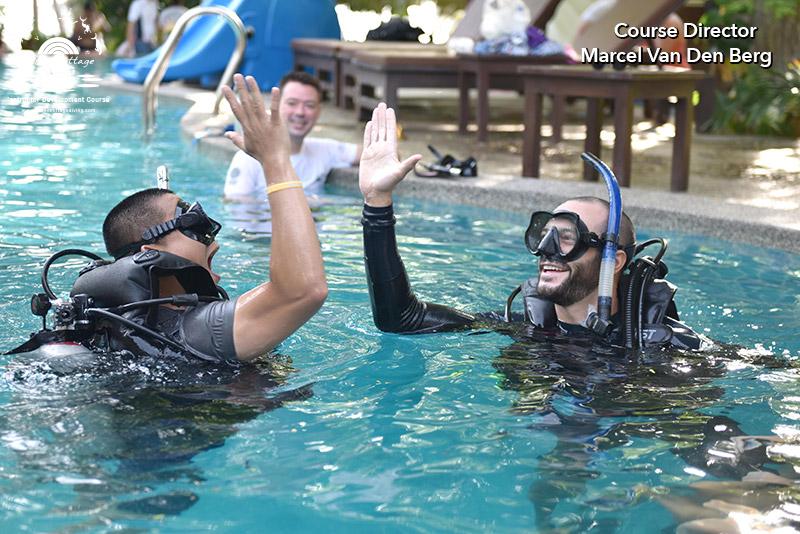The PADI Free-flowing Regulator skill is an important skill to teach as it can be a life-saving technique to use when there is a problem with the scuba regulator’s first stage, like freezing. Many new divers think that the PADI Free-flowing Regulator skill is difficult to perform, but surprisingly it is a very easy PADI skill. New scuba divers will perform this skill during confined dive number 4 in the PADI Open Water Diver course and Diving Instructors learn to teach the Free-flowing Regulator skill in the PADI Instructor Development Course (IDC).

Teaching the PADI Free-flowing Regulator skill Neutrally Buoyant
In this article I will explain how to teach the Free-flowing Regulator skill the right way to get full scores during your PADI IDC and then how to safely teach it in real life. I hope if you like it you can share this article on your social media and leave some comments below.
Why is the Free-flowing Regulator skill such an important PADI Skill?
A Free-flowing Regulator is not very common because these days scuba regulators and specifically first stages are extremely well-designed. However unlikely it is to occur, the first stage of a scuba regulator can freeze when you scuba dive in cold water.
Even if the water is above freezing temperatures the scuba regulator can still free-flow because of a pressure drop from scuba cylinder pressure to intermediate pressure. Depending on the scuba regulator design it can now free-flow, releasing larges amounts of air from the regulator’s second stage. By using a special technique called the PADI Free-flowing Regulator skill, you can still easily breathe from a Free-flowing regulator and safety ascend to the surface.
“Any PADI diving skill can be performed in slightly different ways depending on the style of the Diving Instructor. In this article I want to explain one way of performing the Free-flowing Regulator skill within PADI standards, that is one of the safest, most realistic ways of doing it and which will also get you full scores (5.0) on any PADI IDC Course and the PADI Instructor Examination (IE)”.
Picking the best location for the Free-flowing Regulator skill
Confined Open Water means a swimming pool or an open water area with swimming pool-like conditions. I recommend teaching the Free-flowing Regulator skill in shallow water as students sometimes get nervous when they perform this skill or maybe get some water in their mouth. Being in shallow water knowing that they can stand up, relaxes the student’s mind.
How to organize the PADI Free-flowing Regulator skill
First of all make sure that the area where you perform the Free-flowing Regulator skill is clear from other scuba divers and swimmers. Then place your students in a straight line or half circle next to each other on the bottom of the swimming pool or confined open water. If you have an assistant (PADI Divemaster or Assistant Instructor) than instruct him or her to watch over your students on one side, in-front or behind them. Once everyone is in place Perform a Free-flowing Regulator skill demonstration and then perform the skill with the students one by one or two by two until everyone has completed the Free-flowing Regulator skill.
The Free-flowing Regulator skill briefing
There are many different ways to brief the Free-flowing Regulator skill. During the PADI IDC and IE you need to mention a few points to get full scores:
Objective
Value
Description
Signals
Organization
You can find the Objective in the PADI Instructor manual in Section 3 of the Open Water Diver course in Confined Water dive 4.

Giving a great Free-flowing regulator briefing
Objective:
Breathe effectively from a simulated free-flowing regulator for at least 30 seconds.
Value:
In the unlikely event your regulator freezes and it starts to free-flow. You can then still make a safe ascent to the surface using this technique.
Description:
First tilt your head to the right, then take a deep breath and remove your second stage from your mouth. Put the right side of the mouth piece in your mouth and have the left side of the mouth piece on your left cheek. Using the fingers on your right hand, gently press the purge button of the second stage to simulate the free-flow. Gently start breathing in and out for at least 30 seconds.
Signals:
Signal skill, tilt head, breathing, mouth piece, etc.
Organization:
We are going to do it right here in the shallow end. Please position yourself in half a circle around me. My Divemaster will be looking after you and I will start with a demonstration. After my demonstration I will come up to you one by one until we are done.
Do you have any questions?
This is a great way to explain the briefing but the order is not very realistic. To make it more realistic I recommend to use this order:
Objective
Value
Organization
Description (with signals integrated)
Please integrate the signals by showing them during the description to make it even more realistic.

It is important to have half of the mouthpiece out of the mouth during the Free-flowing regulator skill
This is an example of a more realistic Free-flowing Regulator skill in real life and during the PADI IDC and IE:
“Hi all, the next skill we will be performing is to Breathe effectively from a simulated free-flowing regulator for at least 30 seconds.
This is a great skill to learn because in the unlikely event your regulator freezes and starts to free-flow, you can continue to breathe whilst making a safe ascent to the surface.
We will do this skill right here in the shallow end. Please be in half a circle around me. My Divemaster will be looking after you and I will start with a demonstration. Please keep looking during my demo and afterwards I will ask you if you have understood it. After my demonstration I will come up to you one by one until we are done.
So how are we going to do the Free-flowing Regulator skill? (now you can demonstrate your hand signals while you are explaining this)
First of all please tilt your head to the right, then take a couple of deep breaths. When you are ready remove the second stage from your mouth, leave the right side of the mouth piece in your mouth and have the left side of the mouth piece on your left cheek. Gently press the purge button of the second stage with the fingers on your right hand to simulate the free-flow. Gently start breathing in and out for at least 30 seconds. I will stop you when you have completed the 30 seconds.
Do you have any questions?”
Now this is a much more realistic order for the Free-flowing Regulator briefing.
Best way to demonstrate the Free-flowing Regulator
Start by positioning yourself in front of the students and signal to them that you are about to demonstrate the Free-flowing Regulator skill and that they look at you throughout the full skill demonstration. The first step is to tilt the head to the right. Then show that you are taking a few relaxed breaths. On your final breath take out the mouthpiece from your mouth (leave the right side of the mouth piece in your mouth). Show that you are gently pressing on the purge button and show that your are comfortably breathing in and out. It is important to move your head whilst breathing going from left to right and back so all of the students can easily see what’s happening. Also show that the left side of the mouth piece is on the outside of your left cheek.
Just remember that you don’t have to demonstrate this skill for 30 seconds. You only have to do it between 10 to 15 seconds – enough time for all your students to see the Free-flowing Regulator skill. Also remind your students in the end to resume normal breathing and to maybe clear any water that might have entered the mask.
You can also demonstrate this, the Free-flowing Regulator Skill, whilst neutrally Buoyant! Check out this video on how to do it:
How to perform the Free-flowing Regulator skill with your students
After you completed the Free-flowing Regulator skill demonstration, signal to the PADI Divemaster or Assistant Instructor if they are ok and that they should watch the students that you are not performing the skill with. Then move closer to one of your students and signal to them to start the skill. Make sure you have a working timing device on which you can count seconds with, and make them perform the skill for at least 30 seconds.
I recommend to stop them after 35 seconds, just to be sure you met the PADI performance requirements. Correct any problems if needed and at the end of the skill give the students some positive reinforcement with a handshake or high five and a quick reminder of proper technique if they had any problems during the skill. Then communicate with your Divemaster (or AI) if he/she is ok and direct him/her to watch the students who have completed the skill. Then switch to the next student and ask them to perform the skill until all the students have completed the Free-flowing Regulator skill.

As an diving instructor you should watch your student closly during the PADI Free-flowing regulator skill
Throughout the skill I recommend to either not hold onto the student or maybe just gently hold onto them as you are performing the Free-flowing Regulator skill in shallow water. Holding onto them tightly can make them over-think the skill and they might get more nervous. Just be close enough or hold gently enough to be able to assist the student as necessary and correct problems quickly enough to ensure their safety.
Problems that can occur during the PADI Free-flowing Regulator skill
Not completing the skill for 30 seconds – This problem is very easy to catch if you have a working timing device. I recommend a dive computer with a stopwatch function. Make sure before you start this skill on the Instructor Developer Course that you know how to set it to the stop watch function underwater.
(If you don’t catch this problem on the PADI IDC or IE it will result into a score of 1.0 – this means you failed the skill presentation)
Holding breath – This problem is very hard to catch on the Free-flowing Regulator skill especially during the PADI IDC. The reason for this is because of all the bubbles escaping from the second stage. Some people have said to use your hand to feel their chest, but I don’t recommend it as it can be considered inappropriate. I recommend to watch the breathing movement of the body.
(If you don’t catch this problem on the PADI IDC or IE it will result into a score of 1.0)
Head to the left – You can still perform the skill, but we recommend to tilt the head to the right because of the regulator hose.
(If you don’t catch this problem on the PADI IDC or IE you will receive a 2.0 only on problem solving, you can still pass if other criteria are met)

PADI IDC candidate at Sairee Cotatge Diving giving a flawless Free-flowing regulator briefing
Wrong position of the mouthpiece – The right side of the mouthpiece should be in the mouth and the left side should face up on the outside of the left cheek of the student. Any other position by leaving the mouthpiece in the mouth, fully outside the mouth or any other position is considered a problem.
(If you don’t catch this problem on the PADI IDC or IE it will result into a score of 1.0 or 2.0 depending on the situation.
Not purging correctly – Some students press the purge button too softly or too hard.
(If you don’t catch this problem on the PADI IDC or IE it will result into a score of 1.0 or 2.0 depending on the situation.
There are not a lot of problems that can go wrong during the PADI Free-flowing Regulator skill, so it is quite easy to perform. The only problem that is very hard to catch is breath-holding during the skill, especially on the PADI IDC and IE – So pay extra attention to this problem!
Finish the Free-flowing Regulator skill with a great debrief
The same as for the briefing you can debrief your students on the surface or back on land. In real life there are different versions of a good debrief, but a great one to use is the debrief during the PADI IDC Course. In the IDC debrief you have to mention the following to get full points:
Positive reinforcement
Problems that occurred
Solutions to those problems
Reinstate the objective
Remember the value
To make it sound as nice and realistic as possible I recommend for you to say this:
“Great job! You are now all able to breathe effectively from a simulated free-flowing regulator for at least 30 seconds (Reinstate the objective) and I especially liked the way that everyone purged correctly during the skill!! Well done! (Positive reinforcements)

Some positive reinforcement after completion of the Free-flowing regulator skill
However I did see someone holding their breath (Problem that occurred), remember to breath continuously throughout the skill (Solution to that problem), and I also saw someone trying to tilt their head to the left (Problem that occurred), just remember to tilt the head to the right as that is a more comfortable position for the hose (Solution to that problem).
But a really great job, everyone, and remember that this skill is an amazing skill to master in the unlikely event that your regulator freezes and it starts to free-flow. You can then still make a safe ascent to the surface using this technique (Remember the value).
Again great job all, and do you have any questions?”
Conclusion
I hope that these teaching tips on how to conduct the PADI Free-flowing Regulator skill will help you teach this skill in real life and if you follow everything in the article you will get full points for the PADI Free-flowing Regulator skill in confined water during the PADI IDC and/or the PADI IE.
Of course there are many ways to teach the PADI Free-flowing Regulator skill in confined water according to PADI standards – and please use your own style if you prefer – but this is one way of performing the Free-flowing Regulator skill correctly. If you have more tips then please share them in the comments below and don’t forget to “Like” this article and share it with as many people as possible through your social media.
Would you also like to become a PADI Diving Instructor or do you want to recommend a friend? Then please contact us and join our PADI IDC, MSDT or Dive Instructor Internship course with us.

Marcel van den Berg
PADI Platinum Course Director
Sairee Cottage Diving
Koh Tao, Thailand
Like & Share

